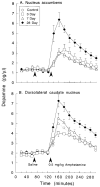Amphetamine-induced time-dependent sensitization of dopamine neurotransmission in the dorsal and ventral striatum: a microdialysis study in behaving rats
- PMID: 7709344
- PMCID: PMC1859849
- DOI: 10.1002/syn.890190108
Amphetamine-induced time-dependent sensitization of dopamine neurotransmission in the dorsal and ventral striatum: a microdialysis study in behaving rats
Abstract
The purpose of this study was to compare the effects of amphetamine exposure on subsequent amphetamine-induced changes in behavior and dopamine (DA) release in the dorsal and ventral striatum, as a function of time following the discontinuation of repeated amphetamine treatment. Rats were pretreated with either saline or an escalating-dose amphetamine regimen, and then received a 0.5 mg/kg amphetamine "challenge" after either 3, 7, or 28 days of withdrawal. Animals tested after 28 days of withdrawal were hypersensitive (sensitized) to the locomotor-activating effects of amphetamine, and relative to control animals showed a significant enhancement in amphetamine-stimulated DA release in both the dorsal and ventral striatum, as revealed by in vivo microdialysis. Animals tested after only 3 or 7 days of withdrawal showed neither behavioral sensitization nor enhanced amphetamine-stimulated DA release. These results establish that time-dependent changes in behavioral sensitization to amphetamine are associated with time-dependent changes in amphetamine-stimulated DA release, and support the hypothesis that persistent sensitization-related changes in striatal DA neurotransmission contribute to the expression of behavioral sensitization.
Figures




Similar articles
-
Expression of sensitization to amphetamine and dynamics of dopamine neurotransmission in different laminae of the rat medial prefrontal cortex.Neuropharmacology. 2001 Mar;40(3):366-82. doi: 10.1016/s0028-3908(00)00174-x. Neuropharmacology. 2001. PMID: 11166330
-
Sparing of behavior and basal extracellular dopamine after 6-hydroxydopamine lesions of the nigrostriatal pathway in rats exposed to a prelesion sensitizing regimen of amphetamine.Exp Neurol. 2004 Sep;189(1):78-93. doi: 10.1016/j.expneurol.2004.05.012. Exp Neurol. 2004. PMID: 15296838
-
Persistent sensitization of dopamine neurotransmission in ventral striatum (nucleus accumbens) produced by prior experience with (+)-amphetamine: a microdialysis study in freely moving rats.Brain Res. 1988 Oct 18;462(2):211-22. doi: 10.1016/0006-8993(88)90549-5. Brain Res. 1988. PMID: 2847849
-
Reductions in binding and functions of D2 dopamine receptors in the rat ventral striatum during amphetamine sensitization.Life Sci. 1999;64(5):343-54. doi: 10.1016/s0024-3205(98)00570-0. Life Sci. 1999. PMID: 10072194
-
Enduring changes in brain and behavior produced by chronic amphetamine administration: a review and evaluation of animal models of amphetamine psychosis.Brain Res. 1986 Jun;396(2):157-98. doi: 10.1016/s0006-8993(86)80193-7. Brain Res. 1986. PMID: 3527341 Review.
Cited by
-
Different Doses of Methamphetamine Are Needed to Produce Locomotor or Blood Pressure Sensitization in Mice.Life (Basel). 2024 Jun 3;14(6):723. doi: 10.3390/life14060723. Life (Basel). 2024. PMID: 38929706 Free PMC article.
-
Parametric studies of antipsychotic-induced sensitization in the conditioned avoidance response model: roles of number of drug exposure, drug dose, and test-retest interval.Behav Pharmacol. 2012 Aug;23(4):380-91. doi: 10.1097/FBP.0b013e32835651ea. Behav Pharmacol. 2012. PMID: 22732209 Free PMC article.
-
Effect of sensitization of stereotypy on the acquisition and retention of tolerance to amphetamine hypophagia.Psychopharmacology (Berl). 1996 Aug;126(3):219-25. doi: 10.1007/BF02246451. Psychopharmacology (Berl). 1996. PMID: 8876021
-
Effects of chronic environmental and social stimuli during adolescence on mesolimbic dopaminergic circuitry markers.Neurosci Lett. 2007 Jul 5;422(1):7-12. doi: 10.1016/j.neulet.2007.04.088. Epub 2007 Jun 9. Neurosci Lett. 2007. PMID: 17590508 Free PMC article.
-
Inhibition of CaMKII in the nucleus accumbens shell decreases enhanced amphetamine intake in sensitized rats.Neurosci Lett. 2008 Oct 24;444(2):157-60. doi: 10.1016/j.neulet.2008.08.004. Epub 2008 Aug 7. Neurosci Lett. 2008. PMID: 18694805 Free PMC article.
References
-
- Akiyama K, Hamamura T, Ujike H, Kanzaki A, Otsuki S. Methamphetamine psychosis as a model of relapse of schizophrenia—a behavioral and biochemical study in the animal model. In: Nakazawa T, editor. Taniguchi Symposia on Brain Sciences, vol. 14, Biological Basis of Schizophrenia. Japan Scientific Societies Press; Tokyo: 1991. pp. 169–184.
-
- Antelman S. Time-dependent sensitization as the cornerstone for a new approach to pharmacotherapy: Drugs as foreign/stressful stimuli. Drug Dev. Res. 1988;14:l–30.
-
- Antelman SM, Chiodo LA. Dopamine autoreceptor subsensitivity: A mechanism common to the treatment of depression and the induction of amphetamine psychosis. Biol. Psychiatry. 1981;16:717–727. - PubMed
-
- Barnett JV, Kuczenski R. Desensitization of rat striatal dopamine-stimulated adenylate cyclase after acute amphetamine administration. J. Pharmacol. Exp. Ther. 1986;237:820–825. - PubMed
-
- Barnett JV, Segal DS, Kuczenski R. Repeated amphetamine pretreatment alters the responsiveness of striatal dopamine-stimulated adenylate cyclase to amphetamine-induced desensitization. J. Pharmacol. Exp. Ther. 1987;242:40–47. - PubMed
Publication types
MeSH terms
Substances
Grants and funding
LinkOut - more resources
Full Text Sources
